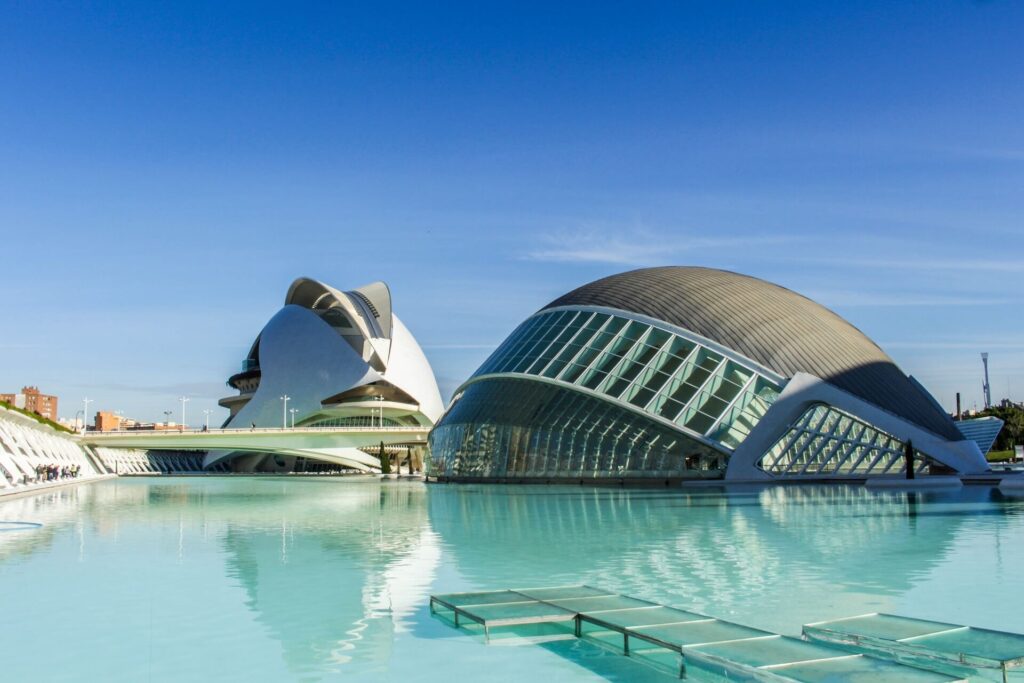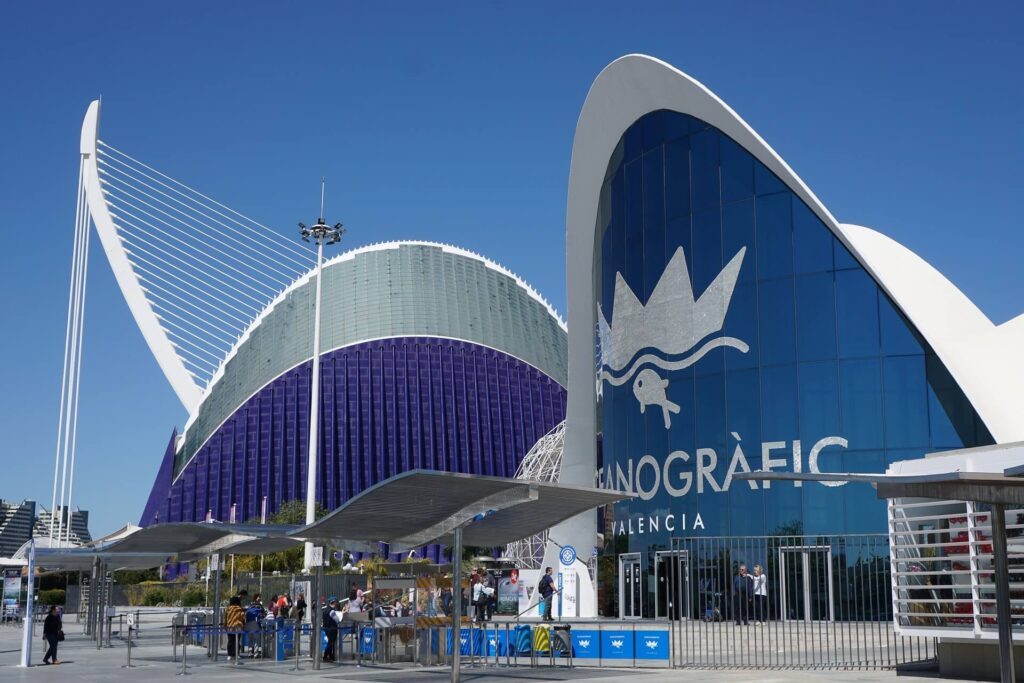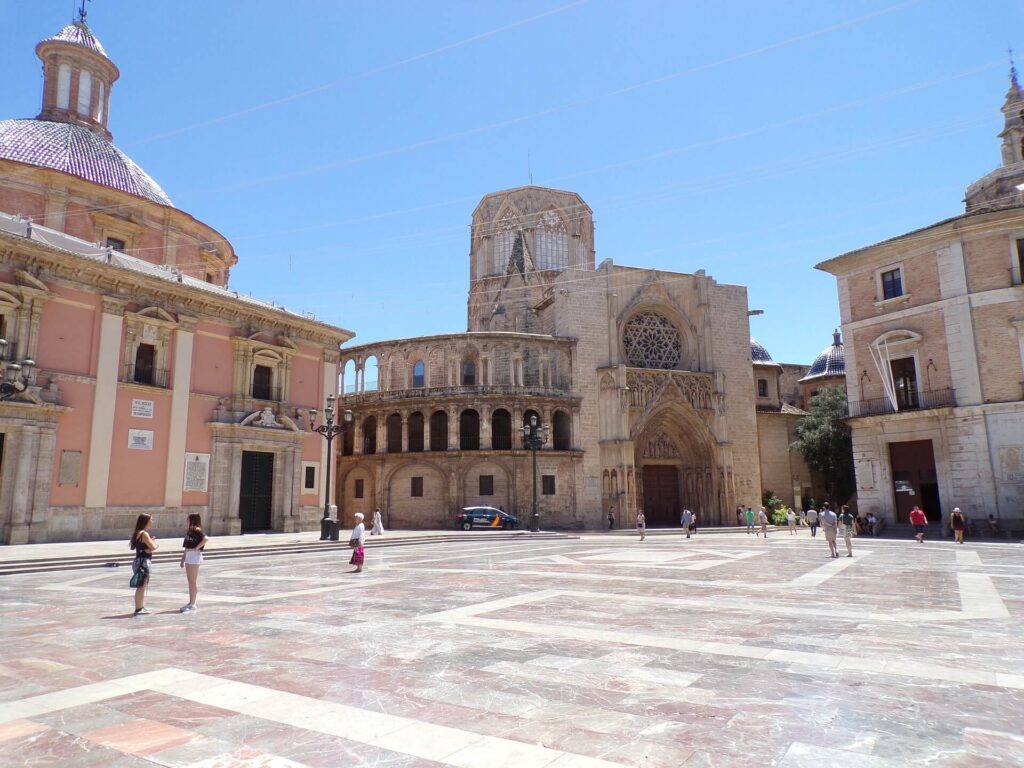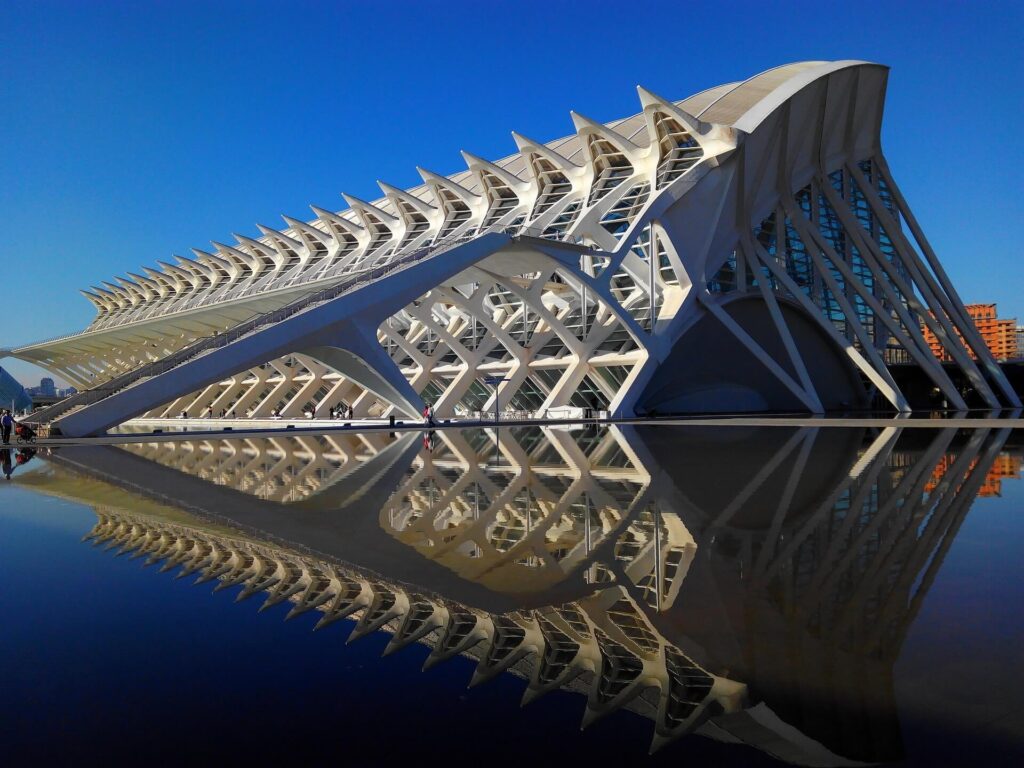Valencia has spent decades playing third fiddle to Barcelona and Madrid, and honestly, that’s worked rather well for it. Whilst those two cities deal with overtourism and eye-watering prices, Spain’s third-largest city has quietly got on with being brilliant – developing one of Europe’s most audacious architectural projects, maintaining proper Spanish character and producing one of the country’s best urban quality of life.
I first visited Valencia back in the early ’90s, back when the City of Arts and Sciences was still a drained riverbed waiting for Calatrava’s vision. Watching the transformation in subsequent visits has been remarkable – not just the headline-grabbing contemporary architecture, but how the city’s woven that futurism into its medieval core without losing the plot. You’ve got Gothic cathedrals minutes from buildings that look like they’ve landed from another planet, traditional markets thriving beside Michelin-starred restaurants, and nine kilometres of parkland running through the centre where a flood-prone river used to be.

What Valencia does exceptionally well is balance. It’s got beaches right in the city but doesn’t feel like a beach resort. It’s the birthplace of paella, which could have turned into tourist-trap territory, yet somehow maintains genuine culinary integrity. The Fallas festival every March is bonkers – enormous sculptures burned in citywide bonfires – but rooted in centuries of tradition rather than invented for visitors.
The Mediterranean climate helps – 300 days of sunshine, mild winters, summers that are hot but not unbearable. The Valencians themselves have this relaxed confidence, less intense than Madrid, less caught up in their own hype than Barcelona. They’re just getting on with life in what happens to be an exceptionally liveable city.
When it comes to things to do in Valencia, you’re looking at genuine variety without the Barcelona-style crowds or the Madrid sense that you’re always rushing to fit everything in. The compact centre means you can cover major attractions on foot, whilst beaches, the Albufera wetlands and proper green spaces remain easily accessible. Here’s what genuinely matters.
Best Things to Do in Valencia
Thirteen might seem generous for a city this size, but Valencia justifies the count. You’ve got world-class contemporary architecture, significant historical sites, beaches, wetlands, festivals, food culture – the variety’s considerable without feeling forced. Some are unmissable regardless of your interests, others depend on what draws you to cities in the first place.
City of Arts and Sciences
The Ciudad de las Artes y las Ciencias dominates discussions of Valencia, and rightly so – it’s one of Europe’s most ambitious architectural projects. Santiago Calatrava and Félix Candela designed this vast complex in what was the Turia riverbed, creating futuristic white structures that either thrill or appall depending on your architectural sensibilities. I’m firmly in the thrilled camp, though I understand the criticism about costs and practicality.
The complex contains several major attractions. The Hemisfèric functions as IMAX cinema and planetarium – that distinctive eye-shaped building you’ll recognise from photos. The Príncipe Felipe Science Museum does interactive exhibits that actually work rather than being tired button-pushing exercises. The Oceanogràfic is Europe’s largest aquarium, with habitats ranging from Arctic to tropical – genuinely impressive scale and the dolphin shows remain popular despite ethical debates. The Palau de les Arts Reina Sofía stages opera and performances, though its acoustics have been contentious amongst performers.

Even if you skip the interiors, walking around the complex is worthwhile. The scale, the reflective pools, the way light plays off those white surfaces – it’s extraordinary. Early morning or late afternoon provides the best light and fewer crowds.
The surrounding area has been developed with landscaped gardens, contemporary sculptures and cycling paths. It’s become Valencia’s statement to the world: we’re not just history and beaches, we’re doing something bold and contemporary.
Valencia Cathedral and the Holy Grail
In complete contrast to Calatrava’s futurism, Valencia Cathedral sits in the old town representing centuries of accumulated history. It’s primarily Gothic but with Romanesque, Baroque and Neoclassical additions – basically every era leaving its mark. The Micalet Tower is worth climbing (207 steps, progressively narrower) for panoramic city views extending to the Mediterranean on clear days.
The cathedral’s famous for claiming to house the actual Holy Grail – the cup Christ used at the Last Supper. The Chapel of the Holy Chalice displays the artefact, a simple agate cup that scholars debate endlessly. Whether you accept the claim matters less than understanding its significance to pilgrims and the cathedral’s identity.

What strikes me about the cathedral isn’t grandeur – it’s not trying to compete with Seville or Toledo – but how it anchors the old town. Plaza de la Virgen, directly adjacent, becomes the beating heart of Valencia’s social life, particularly evenings when locals gather and the fountains are illuminated.
The building’s survived floods, wars, changing regimes and architectural fashions. That longevity creates a weight contemporary structures can’t yet match, regardless of their dramatic forms.
La Lonja de la Seda (Silk Exchange)
The Lonja is Valencia’s UNESCO World Heritage jewel and one of Europe’s finest examples of secular Gothic architecture. Built in the 15th century when Valencia’s silk trade was booming, it’s a monument to mercantile wealth and ambition. The main trading hall (Sala de Contratación) features soaring columns that resemble palm trees reaching towards ribbed vaulting – the effect is simultaneously commercial and cathedral-like.
Walking through reveals intricate stonework, the original orange tree courtyard (Patio de los Naranjos) and upstairs chambers where merchants conducted business that connected Valencia to Mediterranean trade networks from Constantinople to London.
What makes the Lonja significant beyond its architecture is what it represents – Valencia at the height of its economic power, when silk made the city wealthy and influential across Europe. That history adds depth to the building beyond just admiring pretty columns.
It’s also refreshingly uncrowded compared to the cathedral or City of Arts and Sciences. You can actually spend time appreciating details rather than being swept along by tour groups. The admission fee is minimal, making it excellent value amongst Valencia’s attractions.
Turia Gardens
Few cities can claim something as audacious as turning a drained riverbed into nine kilometres of continuous parkland running through the centre. After devastating floods in 1957, Valencia diverted the Turia River and faced a decision about what to do with the empty channel. Rather than the proposed motorway (thankfully), they created the Jardín del Turia.
It’s become Valencia’s defining green space – cycling paths, walking trails, playgrounds, football pitches, fountains, gardens and sports facilities stretching from the City of Arts and Sciences past the Bioparc Zoo and numerous historic bridges. You can rent bikes and ride the entire length, jog it, or just find a shaded spot under orange trees and people-watch.
The gardens connect major attractions whilst providing this continuous green corridor that fundamentally shapes how Valencians experience their city. It’s not just a park you visit – it’s infrastructure that gets used daily by residents commuting, exercising, socialising.
I’ve watched the gardens mature over decades, trees growing, areas being redesigned, usage patterns evolving. It represents successful long-term urban planning rather than quick-fix solutions, which Valencia deserves credit for pursuing despite the initial costs and complexity.
Old Town and Plaza de la Virgen
Valencia’s Ciutat Vella rewards wandering without fixed plans. The narrow medieval streets open suddenly into squares, Gothic buildings sit alongside Baroque churches, and everywhere there’s this layered history that planning couldn’t replicate.
Plaza de la Virgen, framed by the cathedral, the Basilica of the Virgin and the Gothic Palau de la Generalitat, captures Valencia’s essence. By day it’s tourists and locals mixing at café tables. Come evening it transforms – the fountains illuminate, street musicians set up, groups gather and the square takes on this timeless Spanish quality where generations mingle and nobody’s rushing anywhere.
As you wander further, you’ll encounter the Torres de Serranos and Torres de Quart – remaining medieval gates from the old city walls. Climb the Serranos for views over the old town’s terracotta roofs. The streets between are filled with small boutiques, traditional horchaterías serving horchata (tiger nut milk – acquired taste but refreshing in summer), street art in El Carmen district and bars where locals outnumber tourists even in peak season.
Getting lost here is inevitable and entirely the point. Some lanes are barely wide enough for two people to pass. Others open into quiet squares with Renaissance palaces nobody bothers signposting. That’s when Valencia reveals itself – not in guidebook highlights but in accidental discoveries.
Las Fallas Festival
If your visit coincides with Fallas in March, brilliant – you’ll witness Valencia at its most exuberant and slightly unhinged. If not, understanding the festival provides context for the city’s character.
Las Fallas originated with carpenters burning wooden structures to mark spring’s arrival. Over centuries it evolved into this extraordinary event where neighbourhoods commission enormous papier-mâché sculptures (fallas or ninots) – often satirical portrayals of politicians, celebrities or cultural figures. For a week these creations are displayed across the city, some reaching building height with remarkable detail and artistic merit.

The climax comes on La Cremà (the burning) when all but one falla goes up in flames accompanied by fireworks, crowds and controlled chaos. Fire crews stand ready whilst these creations that took months to build burn spectacularly. It’s simultaneously beautiful, wasteful, cathartic and quintessentially Valencian.
The atmosphere during Fallas is electric. Streets fill with processions, traditional dress, mascletàs (deafening daytime fireworks displays), and generalised celebration. Hotels book out months ahead, prices spike and the city essentially stops normal functioning.
I’ve been lucky enough to attend the Fallas festival a few times and it never becomes routine. The commitment – financial, creative, communal – to creating something explicitly designed to be destroyed says something profound about Valencian identity and their relationship with tradition, artistry and celebration.
Albufera Natural Park
Just 10 km south of Valencia’s centre lies the Albufera – a freshwater lagoon and wetland that’s one of Spain’s most important ecological sites. It’s an abrupt shift from urban Valencia to this tranquil landscape of rice paddies, traditional fishing villages and birdlife that attracts ornithologists from across Europe.
Boat trips across the lagoon provide perspectives on the ecosystem and those sunsets that inspired local painters. The light here is distinctive – soft, golden, reflecting off water and rice fields in ways that feel quintessentially Mediterranean.
Albufera’s also where rice cultivation began in Spain, making it paella’s birthplace. The traditional restaurants in villages like El Palmar serve paella cooked over wood fires in settings where the dish actually originated. It’s a different experience from city restaurants – more rustic, less polished, arguably more authentic.
The park demonstrates Valencia’s geographical diversity – beaches to wetlands to city centre all within 20 minutes. That compression of different environments and ecosystems is unusual and adds considerably to the region’s appeal.
Valencia’s Food Culture
Valencia is inseparable from paella, and managing expectations around that becomes important. The classic paella valenciana contains chicken, rabbit, green beans and snails – not seafood. That’s a later invention for tourists who find rabbit and snails challenging. Authentic versions are cooked over wood fires in wide shallow pans, the socarrat (crispy bottom layer) indicating proper technique.
Beyond paella, Valencia’s gastronomy deserves proper attention. Fideuà uses short noodles instead of rice with seafood. Horchata de chufa (tiger nut milk) is refreshingly unusual, typically served with fartons (sweet elongated pastries you dip in the drink). All i pebre (eel stew) appears in traditional restaurants. Clòtxina (local mussels) from the Albufera are exceptional.
The city’s also got serious fine dining – Michelin-starred restaurants like Ricard Camarena and Quique Dacosta reinterpreting traditional Valencian ingredients with contemporary techniques. The food scene operates across the spectrum from humble market stalls to global gastronomy without the pretension that sometimes accompanies that range elsewhere.
Central Market (Mercado Central) provides edible education – one of Europe’s largest markets housed in a stunning modernist building. The stained glass, the iron columns, the colourful tiles create architecture that matches the sensory overload of hundreds of stalls selling produce, seafood, meats, cheeses and spices. Even if you’re not cooking, wandering through on a Saturday morning when it’s heaving with locals is quintessentially Valencian.
Valencia’s Beaches
For all its cultural attractions, Valencia’s also a beach city, and proper ones at that. Playa de la Malvarrosa and Playa de las Arenas stretch along the coast just minutes from the centre – wide golden sand, promenade cafés, seafood restaurants and all the infrastructure that makes urban beaches work.
They get busy in summer (naturally), but the scale means they never feel overwhelmed the way Barcelona’s beaches can. The promenade’s been well designed with cycling paths, palm trees and enough space that joggers, cyclists, strollers and skaters coexist without conflict.
Further south near Albufera, El Saler beach offers a more natural setting – backed by dunes and pine forest rather than urban development. The Mediterranean here has that particular quality of light and colour that painters obsess over.
Having beaches this accessible whilst maintaining serious cultural attractions is unusual for cities Valencia’s size. It means you can realistically combine museum mornings with beach afternoons without complicated logistics or feeling you’re missing something.
Museums Beyond the Headline Attractions
The Museo de Bellas Artes houses significant Spanish art – Velázquez, Goya, Sorolla – in a former seminary building that’s lovely in its own right. It’s consistently overlooked by visitors rushing to the City of Arts and Sciences, which means you often have rooms largely to yourself.
The Institut Valencià d’Art Modern (IVAM) showcases contemporary art with rotating exhibitions that bring international shows to Valencia. The Museo Nacional de Cerámica, housed in the ornate Palacio del Marqués de Dos Aguas, is as much about the building as the ceramic collection – that Rococo façade is extraordinary.
These museums reveal Valencia’s breadth – from traditional masters to cutting-edge contemporary work, from fine art to decorative arts. They don’t generate the tourism numbers that major attractions do, which becomes an advantage if you actually want to engage with art rather than shuffle through crowds.
Street Art in El Carmen
Valencia’s emerged as one of Spain’s street art capitals, with El Carmen neighbourhood functioning as an open-air gallery. Large-scale murals transform building façades, alleyways contain hidden pieces and the art ranges from political commentary to playful creativity.
The scene’s organic rather than officially curated – artists work independently, pieces appear and disappear, quality varies wildly. That unpredictability is part of the appeal. You’re genuinely discovering rather than following an official trail, though street art tours exist if you want guided context.
The contrast between Gothic architecture and contemporary murals shouldn’t work but somehow does. It’s another example of Valencia layering different periods and aesthetics without obsessing over perfect preservation or frozen heritage.
Day Trips from Valencia
Valencia’s location makes it a convenient base for exploring further. Xàtiva, 50 km south, has an imposing hilltop castle and medieval centre that reward exploration. Sagunto, just north, features Roman ruins and a fortress revealing the area’s deep history.
Wine enthusiasts should head inland to Utiel-Requena, where Bobal grapes produce distinctive reds that don’t get international attention but are excellent. The landscape shifts from coastal to high plains, offering different perspectives on the Valencian Community.
Each destination is under an hour from Valencia, making them viable day trips without complicated logistics. They add context to understanding the region beyond the city’s urban appeal.
Bioparc Zoo
Worth mentioning for families, Bioparc takes a different approach to zoos – immersive habitats designed to replicate African ecosystems rather than traditional cages. The lemur island, the gorilla enclosure and the savannah areas create environments where barriers are minimised and animals have substantial space.
Ethical debates around zoos continue regardless of design improvements, but if you’re visiting with children, Bioparc represents contemporary best practice in zoo management and conservation messaging.

Frequently Asked Questions about Valencia
How do I get to Valencia?
Valencia Airport sits about 8 km from the centre with flights from major European cities. Metro Line 3 and 5 connect the airport to the centre (roughly 25 minutes). From Madrid, high-speed AVE trains take around 90 minutes. From Barcelona, trains take about 3 hours. Long-distance buses connect Valencia to cities across Spain, though trains are generally more comfortable for those journeys.
How do I get to Valencia from Barcelona?
High-speed AVE train is the most convenient option at roughly 3 hours. Regular departures throughout the day from Barcelona Sants. Driving via the AP-7 motorway takes 3.5-4 hours depending on traffic. Long-distance buses are cheaper but slower and less comfortable – only worth considering if you’re on an extremely tight budget.
Where should I stay in Valencia?
First-time visitors should consider the Old Town (Ciutat Vella) for proximity to historical sites and atmosphere. The area around the City of Arts and Sciences suits families and those wanting modern surroundings. Beachfront districts like Malvarrosa combine sightseeing access with seaside location. The Ruzafa neighbourhood offers local atmosphere and excellent bars and restaurants. Valencia’s compact enough that location matters less than in sprawling cities – you’re never far from anything significant.
When is the best time to visit Valencia?
Spring (March-May) and autumn (September-October) offer ideal temperatures and good light. March brings Fallas if you want spectacle and crowds. Summer’s hot (30-35°C regularly) but beaches become the main draw. Winter’s mild by European standards – rarely below 10°C – though quieter and some attractions have reduced hours. Valencia’s 300+ days of sunshine mean weather’s generally reliable year-round.
Is Valencia good for families?
Exceptionally so. Beaches, the Turia Gardens, interactive science museum, Oceanogràfic, Bioparc and generally relaxed atmosphere make it family-friendly. The compact centre means you’re not exhausting children with endless walking. Restaurants accommodate families naturally rather than treating children as inconveniences. It’s genuinely one of Spain’s best family destinations.
What are Valencia’s main festivals?
Las Fallas in March is the headline event – enormous sculptures burned in citywide bonfires. Feria de Julio runs throughout July with concerts, parades and celebrations. Corpus Christi in June features processions and the Tribunal de las Aguas (Water Court), an ancient institution settling irrigation disputes that’s UNESCO-recognised. Each festival reveals different aspects of Valencian identity and tradition.
How many days should I spend in Valencia?
Three days covers major attractions comfortably – City of Arts and Sciences, old town, cathedral, Lonja, beaches, market and decent food experiences. Four to five days allows for relaxed exploration, day trips to Albufera or surrounding towns, and properly engaging with the food scene. A week makes sense if you’re combining city time with beach relaxation and regional exploration.
A Final Word …
Valencia’s transformation over the past three decades has been remarkable to witness – from somewhat overlooked industrial port to confident cultural destination that’s kept its character whilst embracing bold contemporary architecture and development. The City of Arts and Sciences could have been an expensive folly. Instead it catalysed broader transformation whilst the city maintained its medieval core, food traditions, festivals and that relaxed Mediterranean quality that makes it genuinely liveable.
What Valencia does exceptionally well is avoid trying to be Barcelona or Madrid. It’s developed its own identity – futuristic architecture alongside Gothic landmarks, proper beaches within the city, paella served both authentically and experimentally, festivals that blend ancient tradition with contemporary celebration. The quality of life here is exceptional – locals aren’t fighting overtourism or unaffordable housing (yet), and the city functions for residents rather than existing primarily for visitors.
When it comes to things to do in Valencia, you’re looking at genuine variety across culture, food, architecture, nature and beaches without the Barcelona-style crowds or Madrid’s intensity. The compact centre means you can cover major attractions efficiently whilst still finding quiet corners and accidental discoveries. The climate’s forgiving, the Valencians are welcoming without being dependent on tourism, and the city maintains that balance between accessibility and authenticity that’s increasingly rare in European destinations.
Whether you’re here for Calatrava’s dramatic architecture, Gothic landmarks, paella in its birthplace, the bonkers spectacle of Fallas, or just quality Mediterranean urban life, Valencia delivers without overselling itself. That confidence – we’re excellent without needing to shout about it – might be the city’s most appealing quality.
